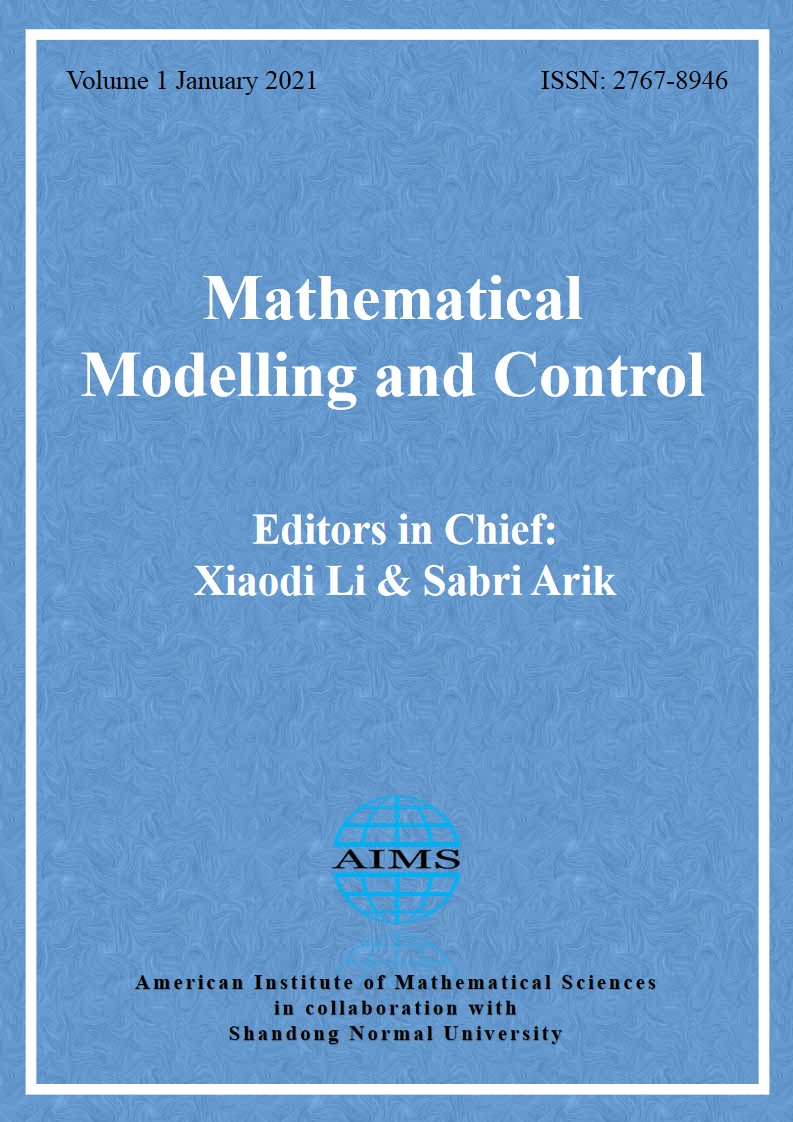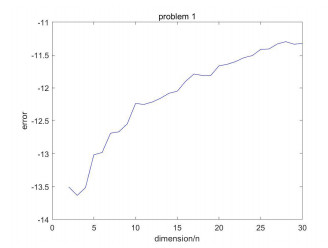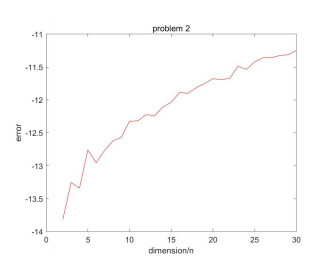1.
Introduction
The purpose of this paper is to study the global behavior of the following max-type system of difference equations of the second order with four variables and period-two parameters
where An,Bn,Cn,Dn∈R+≡(0,+∞) are periodic sequences with period 2 and the initial values x−i,y−i,z−i,w−i∈R+ (1≤i≤2). To do this we will use some methods and ideas which stems from [1,2]. For a more complex variant of the method, see [3]. A solution {(xn,yn,zn,wn)}+∞n=−2 of (1.1) is called an eventually periodic solution with period T if there exists m∈N such that (xn,yn,zn,wn)=(xn+T,yn+T,zn+T,wn+T) holds for all n≥m.
When xn=yn and zn=wn and A0=A1=B0=B1=α and C0=C1=D0=D1=β, (1.1) reduces to following max-type system of difference equations
Fotiades and Papaschinopoulos in [4] investigated the global behavior of (1.2) and showed that every positive solution of (1.2) is eventually periodic.
When xn=zn and yn=wn and An=Cn and Bn=Dn, (1.1) reduces to following max-type system of difference equations
Su et al. in [5] investigated the periodicity of (1.3) and showed that every solution of (1.3) is eventually periodic.
In 2020, Su et al. [6] studied the global behavior of positive solutions of the following max-type system of difference equations
where A,B∈R+.
In 2015, Yazlik et al. [7] studied the periodicity of positive solutions of the max-type system of difference equations
where p∈R+ and obtained in an elegant way the general solution of (1.4).
In 2016, Sun and Xi [8], inspired by the research in [5], studied the following more general system
where p,q∈R+, m,r,t∈N≡{1,2,⋯} and the initial conditions x−i,y−i∈R+ (1≤i≤s) with s=max{m,r,t} and showed that every positive solution of (1.5) is eventually periodic with period 2m.
In [9], Stević studied the boundedness character and global attractivity of the following symmetric max-type system of difference equations
where B,p∈R+ and the initial conditions x−i,y−i∈R+ (1≤i≤2).
In 2014, motivated by results in [9], Stević [10] further study the behavior of the following max-type system of difference equations
where B,p∈R+ and the initial conditions x−i,y−i,z−i∈R+ (1≤i≤2), and showed that system (1.6) is permanent when p∈(0,4).
For more many results for global behavior, eventual periodicity and the boundedness character of positive solutions of max-type difference equations and systems, please readers refer to [11,12,13,14,15,16,17,18,19,20,21,22,23,24,25,26,27,28,29,30] and the related references therein.
2.
Main results and proofs
In this section, we study the global behavior of system (1.1). For any n≥−1, write
Then, (1.1) reduces to the following system
From (2.1) we see that it suffices to consider the global behavior of positive solutions of the following system
where a,b,A,B∈R+, the initial conditions u−1,U−1,v−1,V−1∈R+. If (un,Un,vn,Vn,a,A,b,B)=(Xn,Yn,Z′n,W′n,A2n,B2n,C2n−1,D2n−1), then (2.2) is the first four equations of (2.1). If (un,Un,vn,Vn,a,A,b,B)=(Zn,Wn,X′n,Y′n,C2n,D2n,A2n−1,B2n−1), then (2.2) is the next four equations of (2.1). In the following without loss of generality we assume a≤A and b≤B. Let {(un,Un,vn,Vn)}∞n=−1 be a positive solution of (2.2).
Proposition 2.1. If ab<1, then there exists a solution {(un,Un,vn,Vn)}∞n=−1 of (2.2) such that un=vn=1 for any n≥−1 and limn⟶∞Un=limn⟶∞Vn=∞.
Proof. Let u−1=v−1=1 and U−1=V−1=max{baA,aAB,abB}+1. Then, from (2.2) we have
and
Suppose that for some k∈N, we have
Then,
By mathematical induction, we can obtain the conclusion of Proposition 2.1. The proof is complete.
Now, we assume that ab≥1. Then, from (2.2) it follows that
Lemma 2.1. The following statements hold:
(1) For any n∈N0,
(2) If ab≥1, then for any k∈N and n≥k+2,
(3) If ab≥1, then for any k∈N and n≥k+4,
Proof. (1) It follows from (2.2).
(2) Since AB≥ab≥1, it follows from (2.2) and (2.3) that for any k∈N and n≥k+2,
In a similar way, also we can obtain the other three formulas.
(3) By (2.5) one has that for any k∈N and n≥k+2,
from which and (2.4) it follows that for any n≥k+4,
The proof is complete.
Proposition 2.2. If ab=AB=1, then {(un,Un,vn,Vn)}+∞n=−1 is eventually periodic with period 2.
Proof. By the assumption we see a=A and b=B. By (2.5) we see that for any k∈N and n≥k+2,
(1) If a=b=1, then it follows from (2.7) and (2.4) that for any n≥k+4,
We claim that vn=1 for any n≥6 or Vn=1 for any n≥6. Indeed, if vn>1 for some n≥6 and Vm>1 for some m≥6, then
which implies
A contradiction.
If vn=1 for any n≥6, then by (2.8) we see un=1 for any n≥10, which implies Un=Vn=V10.
If Vn=1 for any n≥6, then by (2.8) we see Un=1 for any n≥10, which implies vn=un=v10.
Then, {(un,Un,vn,Vn)}+∞n=−1 is eventually periodic with period 2.
(2) If a<1<b, then it follows from (2.7) that for any n≥k+4,
It is easy to verify vn=1 for any n≥6 or Vn=1 for any n≥6.
If Vn=vn=1 eventually, then by (2.9) we have
Since Un≥b3un−1 and un≥b3Un−1, we see
which implies
If Vn>1=vn eventually, then by (2.9) we have
Thus,
which implies
If Vn=1<vn eventually, then by (2.9) we have Un−2=Un eventually and un=un−1 eventually. By the above we see that {(un,Un,vn,Vn)}+∞n=−1 is eventually periodic with period 2.
(3) If b<1<a, then for any k∈N and n≥k+2,
It is easy to verify un=1 for any n≥3 or Un=1 for any n≥3.
If un=Un=1 eventually, then
Thus, by (2.6) we have
If un=1<Un eventually, then
Thus,
If un>1=Un eventually, then we have Vn=Vn−2 eventually and vn=1 eventually or vn=vk eventually.
By the above we see that {(un,Un,vn,Vn)}+∞n=−1 is eventually periodic with period 2.
Proposition 2.3. If ab=1<AB, then {(un,Un,vn,Vn)}+∞n=−1 is eventually periodic with period 2.
Proof. Note that Un≥BaAun−1 and Vn≥AbBvn−1. By (2.5) we see that there exists N∈N such that for any n≥N,
It is easy to verify that un=1 for any n≥N+1 or vn=1 for any n≥N+1.
If un=vn=1 eventually, then by (2.11) we see that Un=Un−1 eventually and Vn=Vn−1 eventually.
If uM+2n>1=vn eventually for some M∈N, then by (2.11) and (2.4) we see that
By (2.11) we see that Un is bounded, which implies B=b.
If UM+2n−1≤BVkaAuM+2nuM+2n−1vM+2n−1⋯ukvk eventually, then
Thus, UM+2n+1=UM+2n−1 eventually and uM+2n=uM+2n−2 eventually. Otherwise, we have UM+2n+1=UM+2n−1 eventually and uM+2n=uM+2n−2 eventually. Thus, Vn=Vn−1=max{1,AbB} eventually since limn⟶∞Vkun−1vn−1⋯ukvk=0. By (2.2) it follows UM+2n=UM+2n−2 eventually and uM+2n+1=uM+2n−1 eventually.
If vM+2n>1=un eventually for some M∈N, then we may show that {(un,Un,vn,Vn)}+∞n=−1 is eventually periodic with period 2. The proof is complete.
Proposition 2.4. If ab>1, then {(un,Un,vn,Vn)}+∞n=−1 is eventually periodic with period 2.
Proof. By (2.5) we see that there exists N∈N such that for any n≥N,
If a<A, then for n≥2k+N with k∈N,
which implies vn=1 eventually and Vn=max{1,AbB} eventually.
If a=A, then
Which implies
Thus, Vn,vn are eventually periodic with period 2. In a similar way, we also may show that Un,un are eventually periodic with period 2. The proof is complete.
From (2.1), (2.2), Proposition 2.1, Proposition 2.2, Proposition 2.3 and Proposition 2.4 one has the following theorem.
Theorem 2.1. (1) If min{A0C1,B0D1,A1C0,B1D0}<1, then system (1.1) has unbounded solutions.
(2) If min{A0C1,B0D1,A1C0,B1D0}≥1, then every solution of system (1.1) is eventually periodic with period 4.
3.
Conclusions
In this paper, we study the eventual periodicity of max-type system of difference equations of the second order with four variables and period-two parameters (1.1) and obtain characteristic conditions of the coefficients under which every positive solution of (1.1) is eventually periodic or not. For further research, we plan to study the eventual periodicity of more general max-type system of difference equations by the proof methods used in this paper.
Use of AI tools declaration
The authors declare they have not used Artificial Intelligence (AI) tools in the creation of this article.
Acknowledgments
Project supported by NSF of Guangxi (2022GXNSFAA035552) and Guangxi First-class Discipline SCPF(2022SXZD01, 2022SXYB07) and Guangxi Key Laboratory BDFE(FED2204) and Guangxi University of Finance and Economics LSEICIC(2022YB12).
Conflict of interest
There are no conflict of interest in this article.














 DownLoad:
DownLoad: